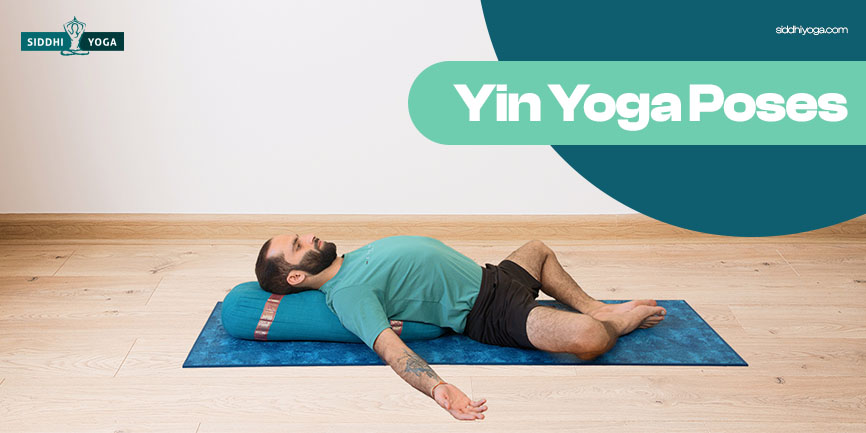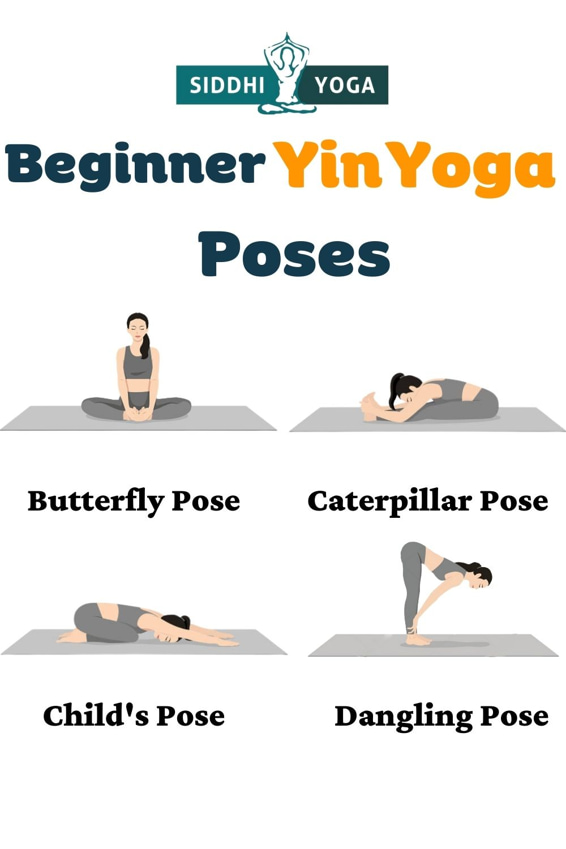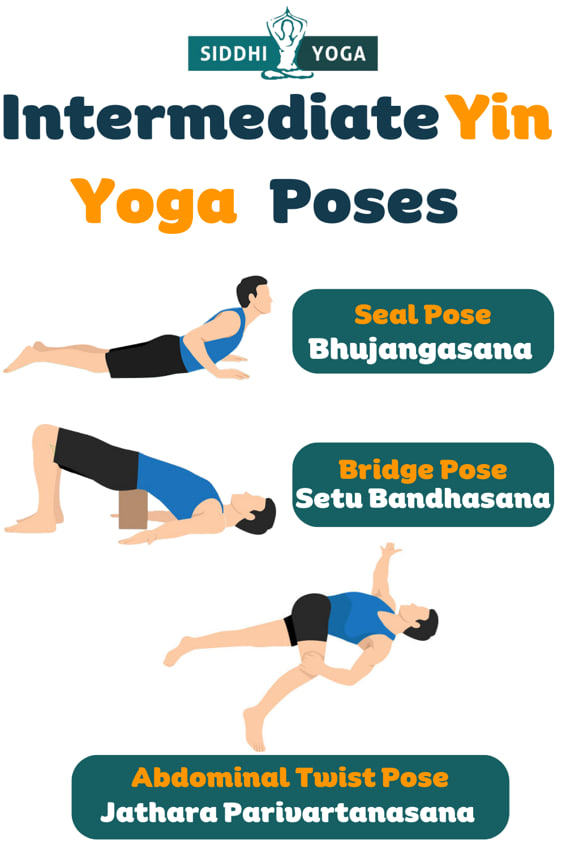
Know more about the Basic, Intermediate and Advanced Yin Yoga poses, their benefits and the best Yoga postures.
Introduction
Yin Yoga is a comparatively new style of yoga practice that came into prominence in the late 1980s. Within a short time, it attracted the interest of yoga practitioners worldwide because of its benefits. The fact that Yin Yoga can be practiced by people of all age groups and at all levels adds to the popularity of this gentle, relaxing practice. Below are some of the best Yin Yoga poses for various levels. You can take up Yin Yoga as a practice or a gentle break between other more vigorous forms of yoga or exercise.
Yin Yoga Basics and Long Poses
Yin Yoga is a slow, contemplative practice with postures that are held for a longer duration than those in Yang Yoga. The poses target deep connective tissue such as fascia, ligaments and tendons while keeping the muscles relaxed. Yin Yoga asanas remove blockages in the energy meridians to allow for a smoother flow of Chi or Prana. There are four main principles underlying each Yin Yoga practice.
- Respect your body’s limits when doing Yin Yoga poses. Once you enter a Yin Yoga posture, wait for your body to indicate that you can go deeper. As you settle into the pose, look for the edge; that threshold of slight discomfort could turn into acute pain. Don’t cross the line. Come out of the pose if the discomfort becomes more acute.
- Once you settle into a pose, try to achieve stillness in body and mind. Breathe normally. As you wait in stillness and silence, sensations and sometimes deep-suppressed emotions can surface. Acknowledge them and let them go.
- Try remaining in the pose for as long as your mindfulness and acceptance of the surfacing sensations grow with the extended hold times of Yin Yoga asanas and your reactions to everyday irritations and stress change. You become more patient and better able to tackle them calmly.
- Enter and exit Yin Yoga asanas gently. The areas under the stretch will be sensitive and need time to return to neutral. Relax in savasana in-between poses.
See Also: Yoga Teacher Training Online
Beginner Yin Yoga Poses

The following Yin Yoga poses for beginners can open up your hips, stretch the spine and help you relax. Check out some of the beginner Yin Yoga asanas here.
Butterfly Pose
- Sit in a comfortable position.
- Bring the soles of your feet together, as close to your body as possible.
- Lean forward so that you feel a comfortable stretch.
- Place folded blankets or bolsters under your hips if your back rounds when you lean forward.
- Place your hands on the floor in front of you.
- Maintain the pose for 3-5 minutes.
- To release, return to a seated position.
Benefits
This Yin Yoga asana lengthens tissues of the hip flexors, hamstrings, lower back and inner thighs. The kidney/urinary bladder meridian and the liver/gall bladder meridian are energized.
Caution
Over-stretching or doing the pose improperly could cause injury to the knee, hip or ankle or aggravate rheumatoid arthritis. Those who recently had an ankle or knee surgery should avoid this pose altogether.
Caterpillar Pose
- Sit comfortably.
- Stretch out your legs in front of you.
- Keep your legs together or hip-width apart.
- Gently bend forward as far as you can go.
- Place your hands by your side, palms down.
- Sit on a cushion or blanket if you cannot keep your back straight.
- You can support your head with bolsters or blocks.
- Place blocks under your knees if that helps you to feel more comfortable.
- Relax and maintain the pose for 3-5 minutes.
- Gently sit back to release the pose.
Benefits
This asana lengthens the spine, relaxes the nervous system and stretches tight hamstrings. This pose also revitalizes the kidney/urinary bladder meridian.
Caution
Over-stretching or doing the pose improperly could cause injury to the shoulders, lower back, hamstrings or hips. If you are suffering from diarrhea, sciatica or slipped disks, or if you are pregnant, seek advice from your instructor.
Child’s Pose
- Start on all fours.
- Sit back on your heels.
- Gently lower your chest to the mat.
- Place a block to support your forehead if it does not touch the floor.
- You can also place blankets or cushions under your knees for support.
- Place your arms in front of you, palms down, or behind you with palms facing up.
- Breathe normally and relax.
- Sit back to come out of the pose.
Benefits
This pose relaxes the neck, back and hips and impacts the stomach/spleen meridian.
Caution
Take extra precautions if you recently had knee surgery or suffer from neck or back pain, high blood pressure, vertigo or slipped discs.
Intermediate Yin Yoga Poses

Intermediate Yin Yoga asanas are for people who have a fair idea about the basics of Yin Yoga practice and want to learn more. The Frog, Half-frog, Swan, Bridge, Shoelace, Seal and Staff are some poses for those in this category. Check out the following intermediate Yin Yoga asanas and watch this video to learn intermediate-level Yin Yoga full body stretches.
Seal Pose
- Lie prone on the floor.
- Move your elbows ahead of your shoulders and prop yourself up.
- Stretch your neck and drop your head back.
- If the sensations in the lower back feel uncomfortable, move your elbows further ahead and lower your chest closer to the floor.
- Maintain for 3-5 minutes.
- To release, slowly lower your chest to the floor.
- Rest your cheeks on your palms and relax.
Benefits
This pose provides stimulation and deep compression of the sacral-lumbar arch and tones the spine. It is therapeutic for people with bulging or herniated disks. The thyroid is stimulated if the head is dropped back. Digestive organs receive a massage and stretch.
Caution
Take extra precautions if you have a bad back, tight sacrum or a headache. Pregnant women should avoid this pose.
Bridge Pose
- Begin with the Corpse Pose.
- Fold your knees and bring your feet close to the hips.
- Keep your feet flat on the floor.
- Lift your hips.
- Press your feet on the floor for additional support when lifting your hips.
- Tuck your shoulders in.
- Let your arms rest on the side with your palms on the floor.
- Make use of your thighs, hips and back muscles to lift your hips as high as possible.
- Position your hamstrings to parallel to the floor to ensure that your ankles align with the knees.
- Keep your chest open and relaxed on the floor.
- Breathe normally and maintain the pose for 3-5 minutes.
- To come out, untuck the shoulders, lower your spine and straighten your legs.
- Relax in Corpse Pose.
Benefits
This pose helps in realigning the spine and preventing rounded shoulders. The chest, neck, and spine get a stretch. It stimulates the abdominal and female reproductive organs, lungs and thyroid.
Caution
This pose should not be done by people who suffer from neck injuries, stomach ulcers or hernias. Women should not attempt it during menstruation.
Abdominal Twist Pose
- Lie in a supine position with your hands by your side and palms facing upwards.
- Fold your knees and bring them close to your chest.
- Keep your knees together and twist to the left side.
- Let the knees touch the floor.
- You can use a bolster to rest your knees.
- Turn your head to the right.
- Do not turn your head if you have neck issues.
- Bring your head and knees back to the centre position to release. Support the knees with your hands pressed to the ground.
- Rest for a while in savasana and repeat on the other side.
Benefits
This posture impacts the heart, digestive system, liver, gallbladder, kidneys, spine, neck, and shoulders. It stimulates and improves circulation in the digestive system and strengthens the abdominal organs. The Yin Yoga pose also releases tension in the spine.
Caution
If you suffer from diarrhea or spine or back injuries, this pose should not be done. Women undergoing their periods or pregnant should also refrain from doing this asana.
Advanced Yin Yoga Poses
Camel, Dragon, Saddle, Snail, Advanced Squat and Advanced Toe Squat are advanced Yin Yoga poses that simultaneously target many areas of your body. Some of them are explained below.
Dragon Pose
- Start on your hands and knees.
- Slide one foot between the hands until the knee is above the ankle.
- Slide the other knee as far back as possible so the leg is stretched out and the foot extended.
- Rest your hands by the side of the front foot.
- Place a blanket under the back knee and a bolster under the shin if that helps to make it more comfortable.
- Look forward or down.
- Breathe normally and hold for 3-5 minutes.
- To release, use the support of your hands and the floor to gently slide the trailing leg forward and the front leg back to return to all four positions.
- Repeat with the other leg.
Benefits
The Dragon Pose stretches the groin, hamstrings, spine, hip flexors, quadriceps, shoulders and wrists and can help ease sciatica. It stimulates the liver, spleen, kidneys, stomach and gallbladder meridians.
Caution
This pose is not for those suffering from knee issues, hernia, pelvic problems, slipped discs and back pain.
Saddle Pose
- Sit on your heels.
- Your knees should be hip-width apart.
- Adjust your position so that your buttocks settle between your feet.
- Place your palms and then elbows on the floor beside your feet.
- Gently lean back till you lie flat on the floor.
- You can also rest your back on a bolster.
- Place your hands by your side or above your head.
- Breathe normally and hold the pose for 3-5 minutes.
- To release, use the support of your elbows and your palms to return to an upright position.
Benefits
This Yin Yoga pose opens up the sacral-lumbar arch and stretches the hip flexors and quadriceps. It stimulates the thyroid. Placing the feet beside the hips allows for good internal rotation. This pose is good for the digestive, urinary bladder, liver and reproductive systems.
Caution
This Yin Yoga asana is not advised for those suffering from a bad back or tight sacroiliac joints. Avoid this pose if you have had an injury or recent surgery on your knees or ankles.
Camel Pose
- Kneel on the floor.
- Keep your thighs, knees and feet together.
- Place your palms on your hips and gently push forward and arch your back.
- Reach your hands back to touch or hold your heels.
- Extend your ribcage and broaden your chest.
- Hang your head back and relax your face.
- Breathe normally.
- Hold the pose for 3-5 minutes.
- To release, raise your head, then engage your hip and thigh muscles to bring your torso up.
- Lower your hips towards the heels and return to a seated position.
Benefits
The Camel Pose helps to correct posture and increases lung capacity. It tones the muscles of the back and spine and removes stiffness in the shoulders, back and ankles. This pose also relieves abdominal cramps, regulates menstrual flow, improves blood circulation to all body organs, and alleviates breathing difficulties.
Caution
Avoid this Yin Yoga asana if you have constipation, diarrhea, headaches, and hypertension.
Best Yin Yoga Pose For You
One of the best Yin Yoga poses that would give you a bagful of benefits would be the Wall Caterpillar Pose. All wall Yin Yoga poses are extra relaxing because you have the support of a sturdy wall to perform an asana. It removes the minimum strain required to perform a Yin Yoga posture. People with physical barriers that limit flexibility when doing the Seated Caterpillar Pose will find this easy.
Wall Caterpillar
- Sit sideways against the wall.
- Gently swing your legs against the wall as you lie down.
- The legs should be at a 90-degree angle to your body.
- Slide your sit bones as close to the wall as possible.
- You can support your sacrum with a small cushion.
- Place your arms by your side, palms up.
- Relax your shoulders.
- Rest in the pose for 1-3 minutes.
- Breathe normally.
- To come out of the pose, fold your knees towards the chest and roll over to one side.
- Supporting yourself with your hands, gently come back to a seated position.
Benefits
Wall Caterpillar is a deeply relaxing and calming pose for the whole body. It increases circulation, reduces swelling of your feet and legs, and prevents varicose veins. This Yin yoga pose stretches the lower back and hamstrings and improves digestion. Since the urinary and bladder meridians are impacted, the pose keeps the urinary tract, prostate gland, testicles and ovaries healthy.
Caution
Pregnant women and those with high blood pressure, hiatal hernia, glaucoma and detached retina should not practice this pose.
The Bottomline
The above Yin Yoga asanas are but a few among many beneficial postures. Enlist for a class under a trained teacher to learn more Yin Yoga poses that target and relieve your unique physical and mental issues — and learn a yoga style that is gentle on your body, is suitable for any age or level and directs you towards a spiritual path.
To know more about Yin Yoga, enroll now for ‘Yin Yoga Teacher Training Certification Course‘ and unlock the transformative benefits of this gentle practice. Experience deep relaxation, improved flexibility, and a profound sense of balance. Don’t wait, start your Yin Yoga journey today!